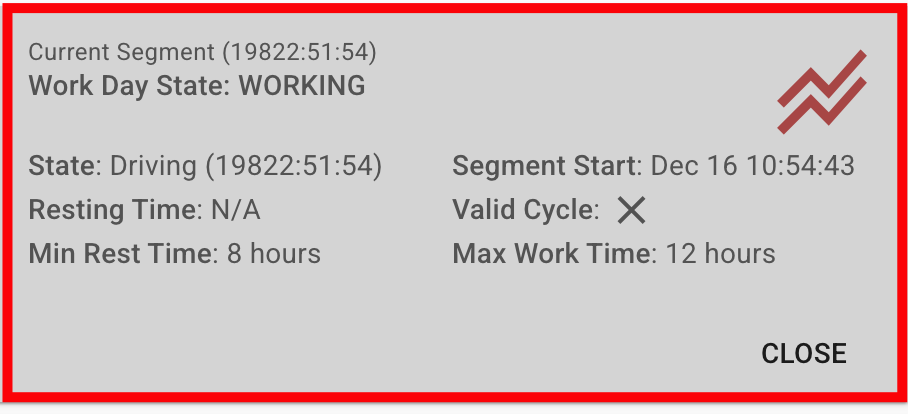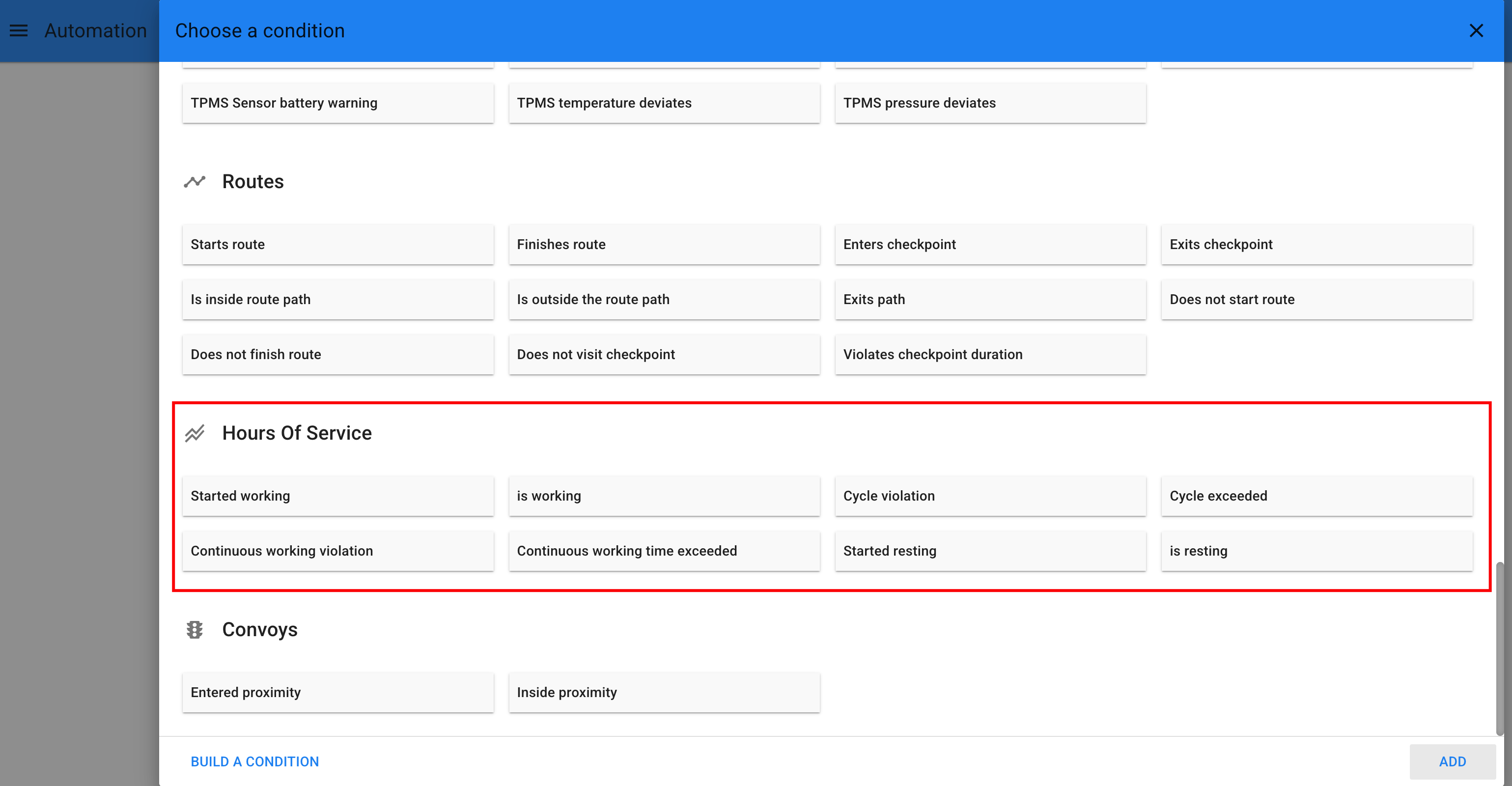Hours of Service
The Hours of Service feature helps manage work hours, breaks, and rest periods for entities. Each entity follows a work cycle based on its daily schedule, typically consisting of a working segment followed by a resting segment.
A cycle begins with work and automatically ends when the vehicle fulfills the required rest time. If needed, a segment can also be manually closed. When we say "close the cycle," it means completing and saving the current segment in the database and starting a new cycle with the next event.
To view the current cycle of a specific entity, double-click on it after filtering. This takes you to the dashboard, where you'll find various sections or "cards" displaying information about the entity's status. The Current Cycle card provides details about the current segment. For example:
- Current Segment: Indicates how long the entity has been in the current segment.
- Work Day State: Indicates the current segment, it can be Working or Resting.
- State: Indicates whether the entity is
- Driving: The entity is in the working segment and is currently driving.
- At Rest: The entity is in the working segment, but at this moment is stopped.
- Resting: The entity is in the resting segment.
- Resting Time: Shows the duration of any current rest period during the working segment. For example, if the entity has its segment configured with the motion signal, when the entity stops, the Resting Time will start counting the time it has been resting. When the entity starts moving again, the Resting Time is reset and will begin to display when the entity stops again.
- Min Rest Time: Specifies the minimum hours of continuous rest required for the entity to automatically transition to a resting segment.
- Segment Start: Displays the date when the segment began. For segments configured based on movement, the vehicle is considered to be working when its speed exceeds 3 mph.
- Valid Cycle: Shows an icon indicating whether the cycle is valid or not. If the entity is overworked, the cycle is marked as invalid.
- Max Work Time: Indicates the maximum hours that the entity can work within its cycle. If the entity works beyond this specified time, it will be considered overworked, resulting in an invalid cycle. For instance, if the Max Work Time is set to 8 hours, the entity becomes overworked if it works for more than 8 hours, rendering the cycle invalid.
Working Cycle without a Resting Time
If the vehicle's device is sending a moving signal, it means the current cycle is in a working segment, indicating continuous movement without resting time.

- State Driving: The entity is in the working segment and is currently driving. It has been continuously driving since the segment/cycle began, so the driving time and current segment will be the same.
- Resting Time: In this case, it's marked as "N/A" since the vehicle is currently moving.
- Min Rest Time: The vehicle needs to rest for at least 8 hours. When it stops for at least 8 hours, the working segment ends automatically, and a resting segment is created upon the next event.
- Valid Cycle: The cycle is valid because the entity has been driving only 3:40:54.
- Max Work Time: The entity becomes overworked if it works for more than 12 hours, rendering the cycle invalid.
Working Cycle with Resting Time
In this example, although the vehicle in the image below has stopped moving for 5 seconds, it is still in a working segment. The Resting Time displayed on the card indicates the duration for which the vehicle has been stationary. Additionally, the icon located on the top right of the card signifies this recent stop.

- Current segment: The entity has been working for 2:47:33.
- State At Rest: The entity is stopped if the signal is moving or has the ignition off if the signal is ignition.
- Resting Time: The entity has been stopped/Ignition Off for 2:38:33.
Resting Cycle
When the entity remains stationary for at least the specified minimum rest time (in this case, when the signal indicates movement but the entity is not moving), the current working segment is automatically closed, and a new resting segment is created.

Manually Closing an Overworked Cycle when the Device is Online
If the vehicle exceeds the maximum work time, rendering the cycle invalid, it can be manually closed by clicking on the "CLOSE" button. It's important to note that only cycles marked as invalid can be closed manually.

Clicking on the "CLOSE" button, as depicted in the image above, triggers a confirmation dialog. This dialog informs the user that the current cycle will be closed, and a new segment will be automatically created during the next event. If the next event indicates no motion, signifying that the vehicle is stationary, a new resting segment will be generated. Conversely, if the next event received indicates motion (in this case, the signal indicates movement), a new working cycle will be created.

Manually Closing an Overworked Cycle when the Device is Offline
When the device is offline and a cycle is manually closed due to overwork, the current cycle will be indicated as being in a resting state. Once the device reconnects online, Pegasus will update all previous segments and cycles based on the received events.
Cycle Status
The cycle status is represented by an icon located in the top right corner of the Current Cycle card. Users can also filter cycles based on their status if they are searching for cycles with a specific status.

- Working: Indicates that the entity is actively working, and the current cycle is in a working segment.
- On break: Represents that the vehicle has initiated a break, typically occurring when it stops or turns off (depending on the configured signal). At this stage, the cycle is still considered working, and the vehicle has not yet rested for more than the minimum resting time.
- Resting: Represents that the current cycle has transitioned into a resting segment. At this point, the entity has completed a working segment and is presently in a resting segment.
- Overworked: Indicates that the vehicle has been working continuously without breaks for longer than the Maximum Continuous Working Time (configured by the Admin in the setup segment) or has exceeded the maximum work time.
- N/A: Denotes that the device does not have the segments configured.
Triggers Associated with HOS
Associated triggers with Hours of Service (HoS) allow you to set up actions triggered when certain conditions related to HoS are met. For detailed instructions on creating triggers, please refer to the Automation section.

You can find more information about this conditions in: https://pegasus.digitalcomtech.com/docs/automation-triggers#conditions
Updated about 2 months ago
